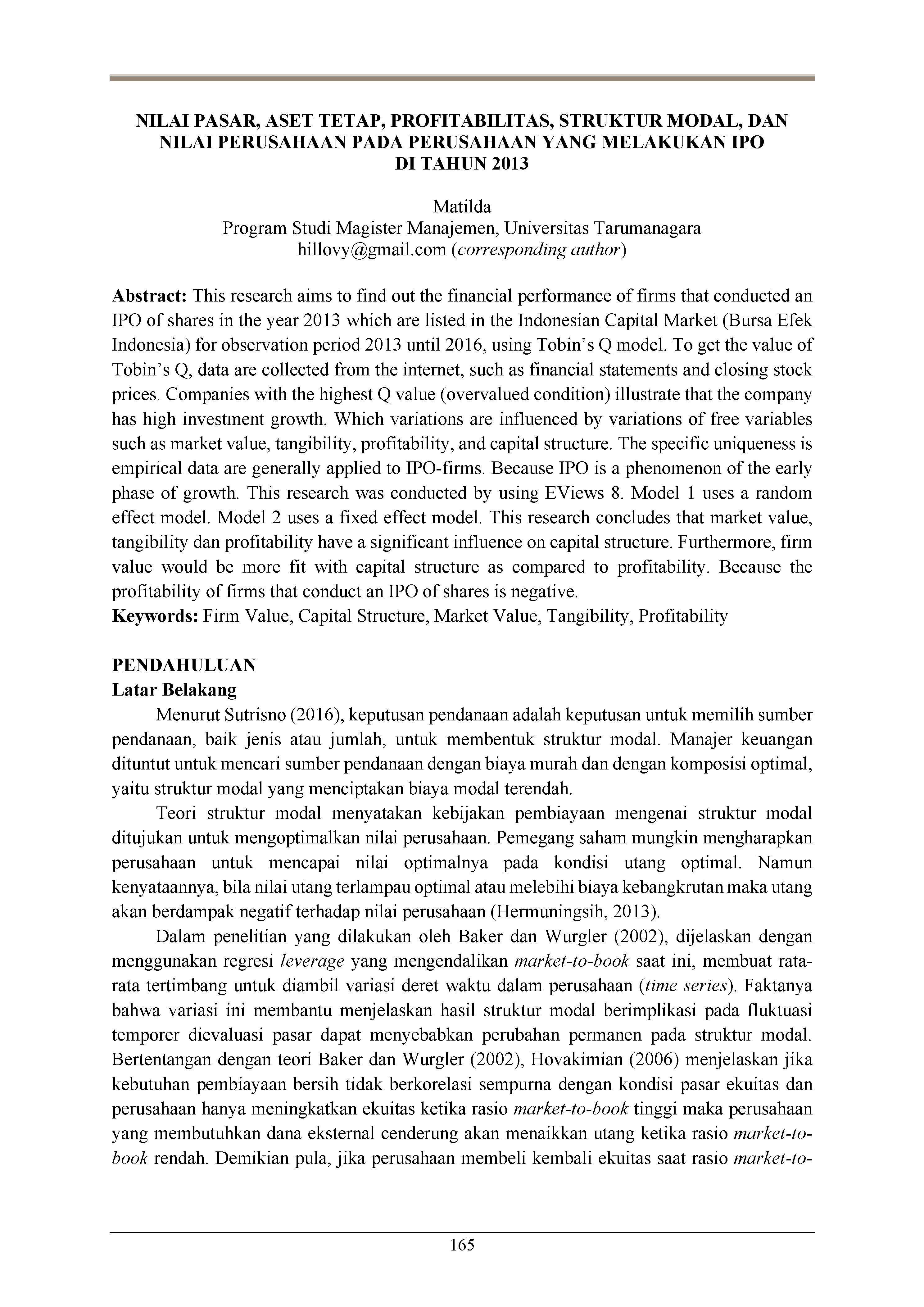Nilai pasar, aset tetap, profitabilitas, struktur modal, dan nilai perusahaan pada perusahaan yang melakukan IPO di tahun 2013
Main Article Content
Abstract
This research aims to find out the financial performance of firms that conducted an IPO of shares in the year 2013 which are listed in the Indonesian Capital Market (Bursa Efek Indonesia) for observation period 2013 until 2016, using Tobin’s Q model. To get the value of Tobin’s Q, data are collected from the internet, such as financial statements and closing stock prices. Companies with the highest Q value (overvalued condition) illustrate that the company has high investment growth. Which variations are influenced by variations of free variables such as market value, tangibility, profitability, and capital structure. The specific uniqueness is empirical data are generally applied to IPO-firms. Because IPO is a phenomenon of the early phase of growth. This research was conducted by using EViews 8. Model 1 uses a random effect model. Model 2 uses a fixed effect model. This research concludes that market value, tangibility dan profitability have a significant influence on capital structure. Furthermore, firm value would be more fit with capital structure as compared to profitability. Because the profitability of firms that conduct an IPO of shares is negative.
Article Details

This work is licensed under a Creative Commons Attribution-NonCommercial-ShareAlike 4.0 International License.
This work is licensed under a Jurnal Manajemen Bisnis dan Kewirausahaan Creative Commons Attribution-ShareAlike 4.0 International License.
References
Acaravci, S. K. (2015). The determinants of capital structure: Evidence from the Turkish manufacturing sector. International Journal of Economics and Financial Issues, 5(1), 158–171. https://www.econjournals.com/index.php/ijefi/article/view/1039
Alipour, M., Mohammadi, M. F. S., & Derakhshan, H. (2015). Determinants of capital structure: An empirical study of firms in Iran. International Journal of Law and Management, 57(1), 53–83. https://doi.org/10.1108/IJLMA-01-2013-0004
Baker, M., & Wurgler, J. (2002). Market timing and capital structure. Journal of Finance, 57(1), 1–32. https://doi.org/10.1111/1540-6261.00414
Harmono. (2015). Manajemen keuangan: Berbasis balanced scorecard pendekatan teori, kasus, dan riset bisnis (R. Rachmatika (ed.); 1st ed.). Bumi Aksara.
Hermuningsih, S. (2013). Profitability, growth opportunity, capital structure and the firm value. Bulletin of Monetary, Economics and Banking, 16(2), 115–136. https://doi.org/10.21098/bemp.v16i2.440
Hovakimian, A. (2006). Are observed capital structures determined by equity market timing? Journal of Financial and Quantitative Analysis, 41(1), 221–243. https://doi.org/10.1017/S0022109000002489
Hunafa, A., & Nugroho, B. Y. (2014). Pengaruh market timing terhadap struktur modal perusahaan yang melakukan penawaran saham perdana (IPO) yang tercatat di BEI periode 2002 - 2012 [Skripsi, Universitas Indonesia]. https://lib.ui.ac.id/m/detail.jsp?id=20386639&lokasi=lokal
Mahajan, A., & Tartaroglu, S. (2008). Equity market timing and capital structure: International evidence. Journal of Banking & Finance, 32(5), 754–766. https://doi.org/10.1016/j.jbankfin.2007.05.007
Mukherjee, S., & Mahakud, J. (2012). Historical market-to-book ratio and corporate capital structure: Evidence from India. Global Business Review, 13(2), 339–350. https://doi.org/10.1177/097215091201300211
Pangulu, A. L., & Ghozali, M. (2014). Pengaruh profitabilitas, growth opportunity, dan struktur modal terhadap nilai perusahaan (studi pada perusahaan perbankan yang terdaftar di BEI periode 2011-2013). Jurnal Ilmiah Mahasiswa FEB, 3(1), 1–13. https://jimfeb.ub.ac.id/index.php/jimfeb/article/view/1417
Ramaratnam, M. S., & Jayaraman, R. (2013). Determinants of capital structure with special reference to Indian pharmaceutical sector: Panel data analysis. Journal of Commerce & Accounting Research, 2(4), 45–50. http://www.publishingindia.com/jcar/47/determinants-of-capital-structure-with-special-reference-to-indian-pharmaceutical-sector-panel-data-analysis/255/1911/
Riyanto, B. (1995). Dasar-dasar pembelanjaan perusahaan (4th ed.). BPFE.
Ross, S. A., Westerfield, R. W., & Jordan, B. D. (2009). Pengantar keuangan perusahaan (A. A. Yulianto (trans.); 8th ed.). Salemba Empat.
Sari, R. K. (2005). Faktor-faktor yang berpengaruh terhadap nilai perusahaan dengan investasi sebagai variabel moderating di Bursa Efek Jakarta periode 2000 sampai 2002 [Thesis, Universitas Diponegoro]. http://eprints.undip.ac.id/14716/
Sebastian, A. K. (2015). Pengaruh peluang pertumbuhan perusahaan, profitabilitas, dan struktur modal terhadap nilai perusahaan (Pada sektor manufaktur di Bursa Efek Indonesia) [Thesis, Universitas Tarumanagara]. http://repository.untar.ac.id/3838/
Setyawan, I. R., & Frensidy, B. (2012). Empirical tests for market timing theory of capital structure on the Indonesian Stock Exchange. 14th Malaysian Finance Association Conference 2012, 1–20. https://doi.org/10.2139/ssrn.1980014
Sutrisno. (2016). Capital structure determinants and their impact on firm value: Evidence from Indonesia. Economics World, 4(4), 179–186. https://doi.org/10.17265/2328-7144/2016.04.003


